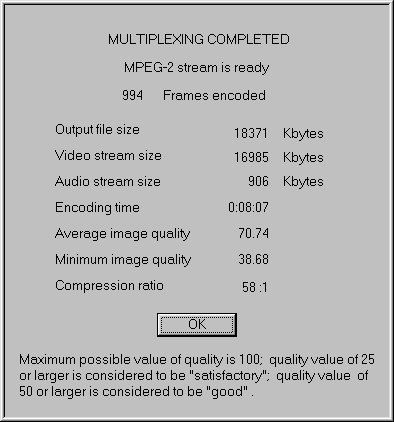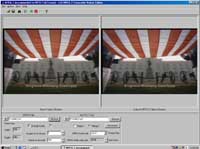The argument can be made that MJPEG is not a widely accepted standard and thus being able to capture using hardware MJPEG is not an advantage over software MPEG2, but for this very purpose Matrox included a MPEG2 Transcoder to convert MJPEG into MPEG1 or MPEG2 files after being captured using the hardware MJPEG codec. This still means that you have to perform the initial capture to disk using MJPEG which, as mentioned before, isn't the most storage efficient, before using the transcoder to convert it to MPEG2.
 The bundled transcoder is the Ligos MPEG2
Transcoder, which supports both SSE and 3DNow! instruction sets. The basic
interface for the transcoder is simple: you select your input file and you select your
output type (MPEG1 or MPEG2 @ whatever resolution you specify) and click the little green
button to proceed with the conversion. Our 93MB MJPEG capture (33 seconds of video at D1
resolution - 704 x 480) came out as an 18MB MPEG2 using the transcoder and a 58:1
compression ratio. In terms of image quality the MPEG2 output file was of somewhat lesser
quality with a definite loss of detail but the overall image quality was a very good
reproduction of the original 93MB MJPEG capture.
The bundled transcoder is the Ligos MPEG2
Transcoder, which supports both SSE and 3DNow! instruction sets. The basic
interface for the transcoder is simple: you select your input file and you select your
output type (MPEG1 or MPEG2 @ whatever resolution you specify) and click the little green
button to proceed with the conversion. Our 93MB MJPEG capture (33 seconds of video at D1
resolution - 704 x 480) came out as an 18MB MPEG2 using the transcoder and a 58:1
compression ratio. In terms of image quality the MPEG2 output file was of somewhat lesser
quality with a definite loss of detail but the overall image quality was a very good
reproduction of the original 93MB MJPEG capture.
One major gripe we had with the bundled transcoder is the limited functionality of the software because it basically converts and that's it. Clicking on the advanced options button resulted in nothing more than a "here's what you get when you order the full version" window, so if you want a bit more functionality out of your transcoder you're probably going to have to shell out an additional $199 for the full version. The full version adds single pass variable bit-rate control (an important feature for adjusting quality which isn't provided for with the version bundled with the Marvel) and multiprocessor support under Windows NT in addition to a number of other features listed here on their special upgrade page for Matrox users.
In essence, MJPEG is unique to this market, supported only by Matrox and it places emphasis on image quality versus compression efficiency. The benefits of MJPEG are two fold: on one hand you get the high quality video capture you want and, on the other, you can convert it to MPEG1/2 at a later time. The only requirements for the Marvel G400 in this sense are a great deal of temporary disk space (to store the MJPEG files as the codec captures in hardware and writes directly to disk first) and not a fast CPU. The beauty of the Marvel G400 as a affordable solution is that disk space is much cheaper than CPU power and it is much easier to go out and pick up another 10GB drive than toss away your Pentium II and pick up a new Pentium III 500.
Cons for MJPEG are also present, the most prominent of them being the disk usage which should be a key consideration of yours if you are thinking of purchasing it.











0 Comments
View All Comments